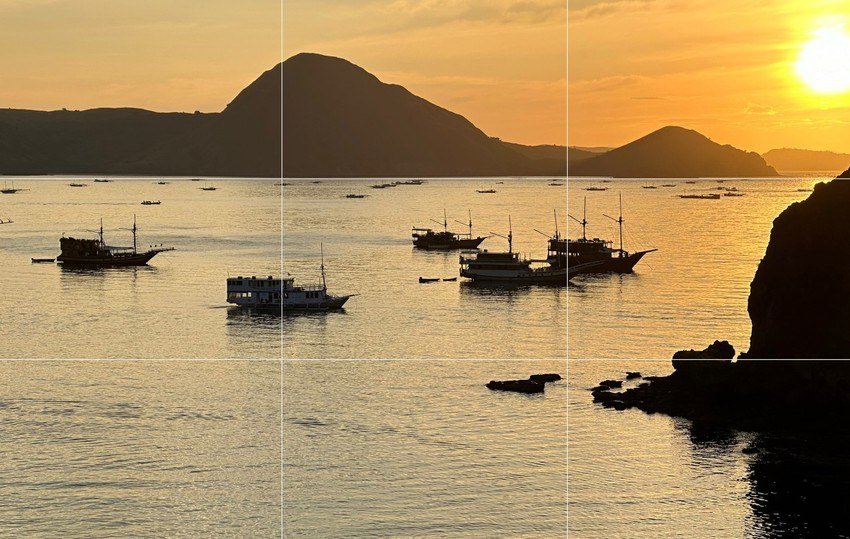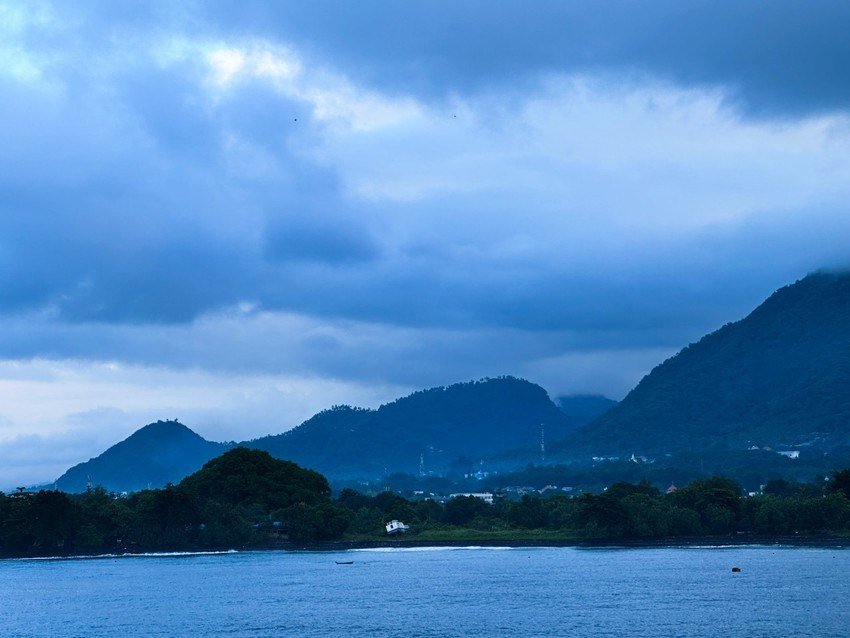Capturing the beauty of the world around us has never been easier, thanks to the powerful cameras in today’s smartphones. With its advanced camera technology, the iPhone allows you to take stunning landscape photos with just a few taps.
Whether you’re an amateur photographer looking to improve your skills or an experienced shutterbug seeking to refine your technique, this guide will provide you with essential tips and tricks for taking better landscape photos on iPhone.
I’ll show you how to transform ordinary scenes into extraordinary images using a few basic composition techniques. So, grab your iPhone, head outdoors, and get ready to capture the splendor of nature like never before.
Rule of Thirds
The rule of thirds is a fundamental principle in landscape photography that helps create balanced, engaging, and visually appealing compositions.
It involves dividing the frame into a 3×3 grid, resulting in nine equal parts.
You guide the viewer’s eye through the scene by aligning important landscape elements with the grid.
For example, placing the horizon along the top or bottom third line rather than in the middle enhances the sense of depth and dimension. Similarly, positioning a tree, mountain peak, or other focal point at one of the four intersections creates a more compelling focal point.

iPhone 14 Pro Max (Padar Island, Indonesia). Copyright © 2024 by Michael Southon
Negative Space
This is another technique that will make your landscape photos more impactful. Negative space refers to the empty or open areas surrounding the main subjects of a photograph.
Negative space in your photos creates a sense of simplicity, tranquility, and focus. This draws the viewer’s attention more strongly to the primary subject.

iPhone 14 Pro Max (Cairns, Australia). Copyright © 2024 by Michael Southon
In landscape photography, negative space often manifests as expansive skies, vast bodies of water, or large stretches of sand or snow.
These areas can serve to isolate the main subject, emphasizing its importance and creating a striking contrast.
Negative space creates a sense of scale by strategically incorporating large, open areas around the main subject to emphasize its size and the vastness of the surrounding environment.
For example, a solitary tree in a wide, empty field can evoke feelings of solitude and introspection. The vast emptiness around the tree magnifies its presence and adds to the scene’s mood.
Images with a large amount of empty space surrounding the main subject help the viewer better appreciate the vastness of the landscape.
This technique can be particularly effective in conveying the enormity of natural features like mountains, deserts, or oceans, offering a sense of the awe-inspiring beauty of the natural world.
Leading Lines
Leading lines are a powerful technique for adding interest, movement, and depth to your landscape photos.
Leading lines direct the viewer’s gaze, making an otherwise static scene more engaging and compelling.
For instance, a winding path through a forest invites the viewer to imagine walking along it, creating a sense of movement and exploration.
The direction and angle of the lines can also influence the mood and atmosphere of the photograph; diagonal lines convey a sense of action or tension, while horizontal lines often create an atmosphere of tranquility and stability.
In addition to guiding the viewer’s eye, leading lines emphasize the scale and grandeur of the landscape.
For example, a road leading into a vast desert can highlight the expanse and emptiness of the terrain.

Photo by Vincent Battault on Unsplash
Similarly, lines that converge in the distance, such as railway tracks or rows of crops, can enhance the perception of depth and infinity.
Leading lines enhance a photograph’s visual appeal and help tell a story, adding layers of meaning and context to the scene.
Layering
Layering is a technique used in landscape photography to create depth and dimension in an image, transforming a flat, two-dimensional photograph into a more lifelike and immersive scene.
This composition technique uses multiple distinct “layers” at different distances from the camera. These layers typically include a foreground, middle ground, and background, each contributing to the overall sense of depth.
In this photo, I included a foreground, a middle ground, and a background to create a sense of depth.

iPhone 14 Pro Max (Padar Island, Indonesia). Copyright © 2024 by Michael Southon
The foreground layer is usually the closest element to the camera and can include objects like rocks, plants, or water. Incorporating a strong foreground element immediately grabs the viewer’s attention and provides a starting point for exploring the rest of the image.
The middle ground, which might feature larger elements such as trees, buildings, or hills, acts as a bridge between the foreground and background, helping to guide the viewer’s eye deeper into the scene.
The background usually consists of distant elements like mountains, sky, or other far-off features, setting the context and scale for the entire photograph.
Layering creates a sense of perspective that leads the viewer’s gaze through the image in a natural and engaging way. This technique enhances the visual interest and conveys a narrative or emotional journey, as each layer can add different textures, colors, and details to the composition.
For instance, a landscape photograph featuring a rugged foreground of wildflowers, a middle ground of rolling hills, and a majestic mountain range in the background can evoke a powerful sense of exploration and discovery.
Layering also helps to create balance and harmony within the composition. By distributing visual weight across different parts of the image, you can prevent any single element from dominating the scene.
The foreground layer is particularly important in landscape photography. It tells the viewer where you were standing when you took the photo, drawing viewers into the scene and making them feel as if they are part of the landscape.
Framing
Framing is a powerful composition technique in landscape photography. In this technique, natural or man-made elements are used to create a ‘frame’ within the image, drawing attention to the primary subject or scene.
This helps to focus the viewer’s attention and adds depth and layers of interest to a photograph.
Natural frames can include overhanging branches, rock formations, or even gaps between trees, while man-made frames might involve arches, windows, or doorways. By encasing the central part of the image, framing can create a sense of context and place, making the scene feel more intimate and composed.

Using a cave entrance as a frame. Copyright © by Michael Southon 2012
Framing helps to isolate the subject from its surroundings, making it stand out more prominently. This is especially useful in complex or busy landscapes where the main subject might otherwise get lost. By creating a boundary around the focal point, framing guides the viewer’s eye directly to the subject. For example, capturing a mountain peak through a natural arch highlights the peak and provides a sense of scale and grandeur.
Framing also enhances the depth and dimensionality of a landscape photograph. By incorporating foreground elements that act as frames, you can create a sense of layers within your image. This adds a three-dimensional quality to a two-dimensional photograph, making the viewer feel like they are looking into the scene rather than just at it.
For instance, using a cave entrance to frame a sunset over the ocean can lead the viewer’s eye from the dark, enclosed space of the cave to the expansive, open vista beyond, creating a journey through the image.
Foreground Interest
Foreground interest is a key compositional technique in landscape photography. Including elements in your image’s foreground creates depth, context, and visual intrigue.
This leads the viewer’s eye into the scene, making the photograph more immersive and engaging. By incorporating compelling foreground elements such as rocks, flowers, water, or other natural features, you can add a sense of scale and dimension, transforming a flat landscape into a three-dimensional image.
In this photo, I included some vegetation in the foreground to show the viewer where I was standing. A strong foreground interest allows the viewer to feel they are looking at the scene in real life.

iPhone 14 Pro Max (Padar Island, Indonesia). Copyright © 2024 by Michael Southon
One of the primary benefits of using foreground interest is the enhancement of depth.
When viewers look at a photograph, their eyes tend to follow a visual path from the foreground to the middle ground and finally to the background.
Including a strong foreground element anchors the viewer’s gaze, providing a starting point for exploring the entire scene.
Foreground interest also creates a sense of scale and proportion in landscape photography.
By juxtaposing a smaller, detailed foreground element with vast background landscapes, you can convey the enormity of the scene. For instance, placing a person or a recognizable object like a tent in the foreground of a sweeping desert landscape can highlight the vastness and isolation of the environment.
This makes the image more relatable and helps viewers appreciate the grandeur of the natural world.
Balance and Symmetry
Balance and symmetry play a key role in landscape photography, adding to an image’s visual appeal and emotional impact.
Balance refers to the distribution of visual weight within a photograph. This can be achieved by carefully placing elements, ensuring that no part of the image overpowers another.
Balanced compositions can be symmetrical or asymmetrical.
Symmetrical balance involves mirroring elements on either side of a central axis, creating a sense of harmony and order. In this photo, I created a mirror image of yachts and their reflection, mirrored on either side of a central axis.

iPhone 14 Pro Max (Cairns, Australia). Copyright © 2024 by Michael Southon
The symmetry in a landscape photo can be horizontal, as in the above image, or vertical, as in the image below.

iPhone 14 Pro Max (Tinabo Island, Indonesia). Copyright © 2024 by Michael Southon
Symmetry in landscape photography evokes a sense of tranquility and stability. When natural or man-made elements are arranged symmetrically, the viewer’s eye is naturally drawn to the center of the image, creating a focal point that anchors the composition.
This is particularly effective in scenes featuring reflections, such as mountains mirrored in a still lake, where the symmetry adds to the serenity and calmness of the scene.
Symmetry can also be found in patterns and repetitions within the landscape, like rows of trees or the regularity of waves, which contribute to the photograph’s overall cohesiveness and structure.
Perspective and Viewpoint
Perspective and viewpoint are key elements in landscape photography, profoundly influencing how a scene is perceived and interpreted.
In photography, perspective refers to the spatial relationship between objects within an image, which can dramatically alter the viewer’s sense of depth and scale.
The viewpoint, or the position from which you capture the image, determines the angle and composition, thereby shaping the overall impact of the photograph.
Choosing the right perspective can transform an ordinary landscape into an extraordinary one. By altering the camera’s position—moving higher, lower, closer, or farther—the photographer can manipulate how different elements within the scene relate to each other.
For example, compare these two photos of a jetty. The first image is taken from a point a few meters to one side of the jetty.

iPhone 14 Pro Max (Cairns, Australia). Copyright © 2024 by Michael Southon
The viewpoint in the second image is much closer, almost underneath the jetty.

iPhone 14 Pro Max (Cairns, Australia). Copyright © 2024 by Michael Southon
The second image is more impactful because it brings the viewer right into the image.
This is the power of perspective. When framing a picture on your iPhone, always consider whether a different perspective would make your photo more impactful.
Pay Attention to Lighting
Lighting is a critical element in landscape photography. It profoundly influences an image’s mood, depth, and overall aesthetic.
The quality, direction, and intensity of light can transform a mundane scene into a breathtaking shot, revealing textures, colors, and details that might otherwise go unnoticed.

iPhone 14 Pro Max (Flores, Indonesia). Copyright © 2024 by Michael Southon
The time of day plays a significant role in determining the quality of light in landscape photography. The golden hours—shortly after sunrise and before sunset—are usually the best time of day for landscape photography, as they produce warm, soft, and diffused light.
When the sun is low in the sky, it casts long shadows and adds depth and dimension to the landscape. This light is ideal for capturing the scene’s intricate details and rich colors, creating a sense of warmth and tranquility.
In contrast, midday light, with its harsh and direct illumination, can create strong shadows and high contrast, resulting in flat and less appealing images.
The direction of light also greatly influences the composition and mood of a landscape photograph.
Front lighting, where the light source is behind the photographer, illuminates the scene evenly, reducing shadows and highlighting colors and details. However, this type of lighting can sometimes make the scene appear flat.
Side lighting, where the light comes from the side of the subject, is excellent for emphasizing textures and creating a sense of depth through the interplay of light and shadow.
Backlighting, where the light source is in front of the photographer, can create dramatic silhouettes and enhance the atmosphere, particularly during sunrise or sunset.
Conclusion
Taking better landscape photos on iPhone involves mastering key composition techniques, including the rule of thirds, leading lines, negative space, layering, framing, foreground interest, symmetry, and perspective.
Try using some of these techniques in your next landscape photos, and you’ll see a significant improvement in the quality of your landscape shots.
With practice and creativity, your iPhone can become a powerful tool for capturing the beauty of the world around you. So, get out there, explore, and start shooting breathtaking landscapes that tell a story and evoke emotion.
Happy photographing!